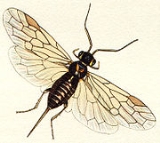
Xyelidae
Encyclopedia
The Xyelidae is a small family of sawflies known from fewer than 50 extant species in 5 genera, but with an extensive fossil record; they are the oldest fossil Hymenoptera
, dating back to the Triassic
, some 200 million years ago. Most species occur in the Northern Hemisphere, especially in boreal
regions, though there are a few neotropical species. Most are associated with conifers (esp. Pinus and Abies), where the larva
e feed on pollen
or within buds, though larvae of a few species feed on the leaves of deciduous
trees.
The family is characterized by the appendages of the head, which are remarkable in that the antennae
and palpi
are nearly leg-like in structure, with a long basal segment followed by a series of tiny segments, as in the tibia-tarsus
. It is tempting to speculate that there is a homeobox
-gene explanation for this unusual anatomy, as mutations of this gene region in other insects can cause the mouthparts and antennae to become leg-like.
Hymenoptera
Hymenoptera is one of the largest orders of insects, comprising the sawflies, wasps, bees and ants. There are over 130,000 recognized species, with many more remaining to be described. The name refers to the heavy wings of the insects, and is derived from the Ancient Greek ὑμήν : membrane and...
, dating back to the Triassic
Triassic
The Triassic is a geologic period and system that extends from about 250 to 200 Mya . As the first period of the Mesozoic Era, the Triassic follows the Permian and is followed by the Jurassic. Both the start and end of the Triassic are marked by major extinction events...
, some 200 million years ago. Most species occur in the Northern Hemisphere, especially in boreal
Boreal ecosystem
The term boreal is usually applied to ecosystems localized in subarctic and subantarctic zones, although Austral is also used for the latter....
regions, though there are a few neotropical species. Most are associated with conifers (esp. Pinus and Abies), where the larva
Larva
A larva is a distinct juvenile form many animals undergo before metamorphosis into adults. Animals with indirect development such as insects, amphibians, or cnidarians typically have a larval phase of their life cycle...
e feed on pollen
Pollen
Pollen is a fine to coarse powder containing the microgametophytes of seed plants, which produce the male gametes . Pollen grains have a hard coat that protects the sperm cells during the process of their movement from the stamens to the pistil of flowering plants or from the male cone to the...
or within buds, though larvae of a few species feed on the leaves of deciduous
Deciduous
Deciduous means "falling off at maturity" or "tending to fall off", and is typically used in reference to trees or shrubs that lose their leaves seasonally, and to the shedding of other plant structures such as petals after flowering or fruit when ripe...
trees.
The family is characterized by the appendages of the head, which are remarkable in that the antennae
Antenna (biology)
Antennae in biology have historically been paired appendages used for sensing in arthropods. More recently, the term has also been applied to cilium structures present in most cell types of eukaryotes....
and palpi
Insect mouthparts
Insects exhibit a range of mouthparts, adapted to particular modes of feeding. The earliest insects had chewing mouthparts...
are nearly leg-like in structure, with a long basal segment followed by a series of tiny segments, as in the tibia-tarsus
Arthropod leg
The arthropod leg is a form of jointed appendage of arthropods, usually used for walking. Many of the terms used for arthropod leg segments are of Latin origin, and may be confused with terms for bones: coxa , trochanter , femur, tibia, tarsus, ischium, metatarsus, carpus, dactylus ,...
. It is tempting to speculate that there is a homeobox
Homeobox
A homeobox is a DNA sequence found within genes that are involved in the regulation of patterns of anatomical development in animals, fungi and plants.- Discovery :...
-gene explanation for this unusual anatomy, as mutations of this gene region in other insects can cause the mouthparts and antennae to become leg-like.
Extant genera
- Macroxyela Kirby, 1882
- Megaxyela Ashmead, 1898
- Pleroneura Konow, 1897
- Xyela Dalman, 1819
- Xyelecia Ross, 1932

